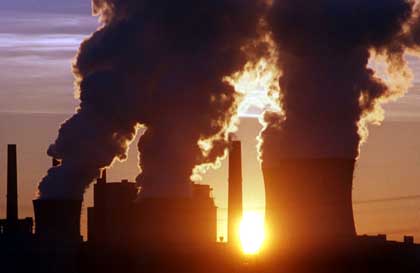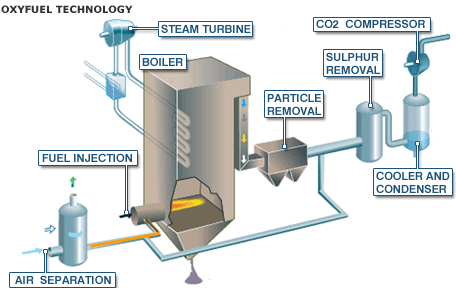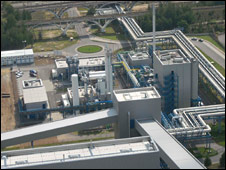 With each large power station releasing millions of tonnes of carbon dioxide every year, and no alternative (clean) power source available immediately, one effective way to reduce carbon gas emissions would be to capture them from the flue gases, and store them securely so that they do not enter the atmosphere.
With each large power station releasing millions of tonnes of carbon dioxide every year, and no alternative (clean) power source available immediately, one effective way to reduce carbon gas emissions would be to capture them from the flue gases, and store them securely so that they do not enter the atmosphere.
Capturing Carbon
Thee are three main ways to capture carbon dioxide gas which would otherwise be emitted by power stations:
pre combusion – convert coal into a clean burning gas, and collect the carbon dioxide released during the conversion.
post combustion – use chemicals to remove carbon dioxide from the power station’s exhaust gases.
oxyfuel – burn coal in a furnace with an atmosphere of almost pure oxygen (i.e. air with nitrogen removed). This ensures that the exhaust gases are 95%+ CO2, and so can be easily collected, liquified, and transported.

Pictured above is a schematic to show the combustion of oxyfuel in a power plant.
CO2 Storage
There are two places where CO2 can practically be stored – under the sea, or in geological formations under the ground. Underground storage is far more likely since there are abundant depleted oil and gas fields, and coal seams which could hold captured CO2 for thousands of years – hopefully with insignificant losses. The technology required is tried and tested as CO2 has been injected into gas and oil fields for years in order to increase yields (EOR – Enhanced Oil Recovery).
Saline aquifers are an alternative potential geological store for captured carbon dioxide. A Saline aquifer is a porous rock deep under the ground which holds salty water (no use for farming or drinking), and could also hold carbon dioxide.
Spremberg Power Station

Back in the autumn of 2008, the Schwarze Pumpe coal-fired power station in Spremberg, eastern Germany became the world’s first carbon emission free coal power plant. This 70 million Euro pilot project collects carbon dioxide gas emitted when oxyfuel is burned, compresses it into liquid form, and then pumps them 1km below the Earth’s surface into porous rocks where they will stay for hundreds of thousands of years.
The EU want to see at least ten similar projects up and running within the next couple of years.
More Information
For more information on carbon capture and storage have a look at the following online resources:
Carbon Capture and Storage – Wikipedia.
Carbon Capture and Storage Association – CCSA.
Access all Areas: Schwarze Pumpe – BBC videos of the Schwarze Pumpe facility in action.
Biochar
NEW – Click here to read our new article What is Biochar? to find out how partially burning wood to make chemically stable charcoal (biochar) locks in carbon dioxide and acts as a soil improver.